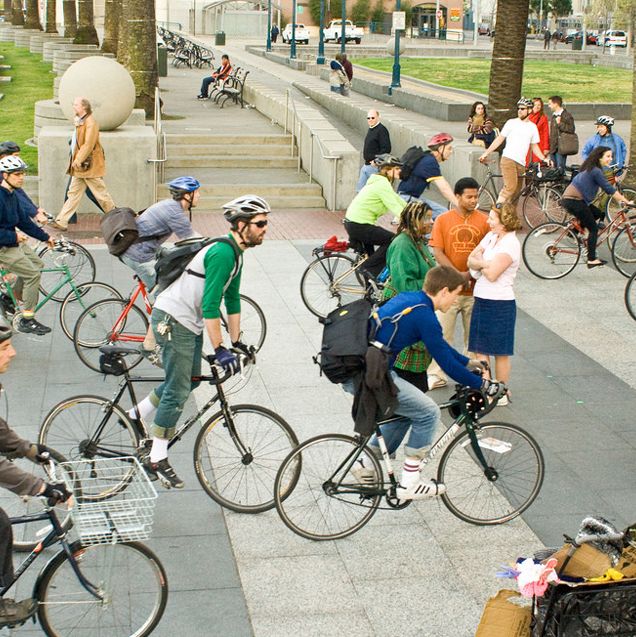City with highest percentage of bike commuters: Davis, CA
Home of the United States Bicycling Hall of Fame, Davis boasts the highest per capita percentage of bike commuters—a sizeable 23.2 percent of the 65,000 population, as compared to the sad nationwide figure of less than 1 percent. That distinction is the primary reason Davis chose to represent itself with a penny-farthing logo and bike-themed motto of “most bicycle friendly town in the world.”
Large city with highest share of bike commuters: Portland, OR
For a city of over 500,000, Portland has the highest per capita percentage of bike commuters (7.2 percent) despite the area’s (somewhat unfair) reputation for incessant rain. With a bike share system on the way and a new policy that makes protected bike lanes the default for new lanes, this cyclist magnet city just continues to improve on its platinum bike-friendly status.
RELATED: 9 Bike to Work Myths Busted
Large city where bike commuting is growing the fastest: Detroit, MI
The Motor City doesn’t get enough credit for its bike-friendliness. Among the top 50 large cities, not only does Detroit (population: 680,281) boast a list of well-regarded local bike makers—Detroit Bikes, Detroit Bicycle Company, Shinola, and AutoBike)—but the city is also home to the most rapidly growing population of cyclists. Between 2000 and 2014, the segment of bike commuters increased by 403.2 percent. That might not be such a dazzling statistic when the resulting segment makes up just 0.8 percent of all commuters in the city, but it’s a big leap in the right direction nevertheless.
City with most cyclists on the streets: New York City, NY
There are so many people in New York City that just having 1.1 percent of the population bike commute (which is still above the national average!) brings the commuter count up to 42,806. That’s a hell of a lot of bikes—and in the next few years, Mayor di Blasio would like to see that number go way up. He vows that by 2020 bicycling will comprise 6 percent of all trips in the city, which could be a possibility considering the uptick in protected bike lanes and how successful the Citi Bike bike-share system has been. One thing’s for sure—if you ride in NYC, you’ll never be without company in the bike lane.
Most bike lanes: Los Angeles, CA
In addition to great weather, as of a 2016 report from bikewalkalliance.org Los Angeles is home to 739.8 miles of on-street bike lanes and 112.9 miles of paved paths—the most of any city in the US. The city could certainly stand to build more protected bike lanes (it currently has just one mile of protected bike lane), but with 1,080 bike facilities planned by 2020 (also the largest total of any other US city), Los Angeles has made it clear increasing bike safety is an important goal moving forward.
Most bike infrastructure per mile: Minneapolis, MN
With 13.4 miles of protected bike lanes, 118.1 miles of on-street bike lanes, and 179.3 miles of paved paths, bike-friendly Minneapolis has the most facilities per mile. That’s not surprising considering the city has long been considered a top bike town despite harsh winters that only seem to make increase the determination and grit of the city’s commuting population.
RELATED: 7 Essential Bike Commuting Tips
Most money spent on bike infrastructure: Washington, DC
Washington, DC devotes more resources to bike and pedestrian projects than any other major US city. The city has also paved the way for bike share in the US, with a thriving Capital Bike Share system that’s second only to NYC in overall number of bikes and ranks first in number of bikes per population. It doesn’t hurt that the city has such great advocacy groups in town, including the national League of American Bicyclists and local Washington Area Bicyclist Association.
One of the safest for cyclists: San Francisco, CA
According to a 2014 benchmark study by bikewalkalliance.org, San Francisco had the lowest cyclist fatality rate with less than one per 10,000 bike commuters. (Although by the time of the 2016 report, Las Vegas had captured that distinction with zero fatalities per 10,000 bicycling commuters.) That’s in part due to the Golden Gate city’s quick response to areas that were previously of danger to cyclists—after a 2013 fatality, protected bike lanes were added to Folsom Street to help prevent future crashes—as well as considerable funds for pedestrian and bike improvements.













